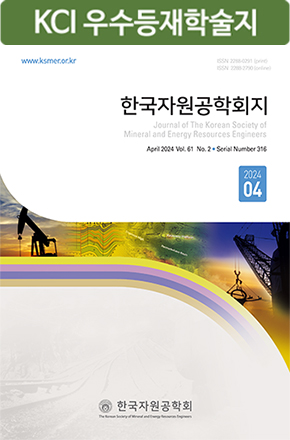Research Paper
- 최요순, Nieto, 2011, “구글어스와 GPSS/H를 이용한 노천 채광장의 적재-운반 시뮬레이션 소프트웨어 개발,” 한국지구시스템공학회지, 제48권 6호, pp. 734-743.
- Ballagh, L.M., Raup, B.H., Duerr, R.E., Khalsa, S.J.S., Helm, C., Fowler, D. and Gupte, A., 2011, “Representing scientific data sets in KML: Methods and challenges,” Computers & Geosciences, Vol. 37, No. 1, pp. 57-64.
- Bay Bridge Public Information Office, 2011, Bay Bridge uses Google Earth to reveal iconic construction process, Available from: http://baybridgeinfo.org, Accessed 70 July 2012.
- Boulos, M.N.K., 2005, “Web GIS in practice III: creating a simple interactive map of England’s Strategic Health Authorities using Google Maps API, Google Earth KML, and MSN Virtual Earth Map Control,” International Journal of Health Geographics, Vol. 4, No. 1, pp. 22.
- Chen, A., Leptoukh, G., Kempler, S., Lynnes, C., Savtchenko, A., Nadeau, D. and Farley, J., 2009, “Visualization of A-Train vertical profiles using Google Earth,” Computers & Geosciences, Vol. 35, No. 2, pp. 419-427.
- Chien, N.Q. and Tan, S.K., 2011, “Google Earth as a tool in 2-D hydrodynamic modeling,” Computers & Geosciences, Vol. 37, No. 1, pp. 38-46.
- De Paor, D.G. and Whitmeyer, S.J., 2011, “Geological and geophysical modeling on virtual globes using KML, COLLADA, and Javascript,” Computers & Geosciences, Vol. 37, No. 1, pp. 100-110.
- Lower Manhattan Construction Command Center, 2011, Construction projects and street impacts, Available from: http://lowermanhattan.info/construction/ipm/4d/map/index.php, Accessed 70 July 2012.
- National September 11 Memorial and Museum, 2011, Google Earth: a virtual look at the World Trade Center site, Available from: http://www.national911memorial.org/google-earth, Accessed 70 July 2012.
- Patterson, T.C., 2007, “Google Earth as a (not just) geography education tool,” Journal of Geography, Vol. 106, No. 4, pp. 145-152.
- Postpischl, L., Danecek, P., Morelli, A. and Pondrelli, S., 2011, “Standardization of seismic tomographic models and earthquake focal mechanisms data sets based on web technologies, visualization with keyhole markup language,” Computers & Geosciences, Vol. 37, No. 1, pp. 47-56.
- Sheppard, S.R.J. and Cizek, P., 2009, “The ethics of Google Earth: crossing thresholds from spatial data to landscape visualization,” Journal of Environmental Management, Vol. 90, No. 6, pp. 2102-2117.
- Sun, E., Nieto, A. and Li, Z., 2010, “GPS and Google Earth based 3D assisted driving system for trucks in surface mines,” Mining Science and Technology (China), Vol. 20, No. 1, pp. 138-142.
- Tomaszewski, B., 2011, “Situation awareness and virtual globes: Applications for disaster management,” Computers & Geosciences, Vol. 37, No. 1, pp. 86-92.
- Yamagishi, Y., Yanaka, H., Suzuki, K., Tsuboi, S., Isse, T., Obayashi, M., Tamura, H. and Nagao, H., 2010, “Visualization of geoscience data on Google Earth: development of a data converter system for seismic tomographic models,” Computers & Geosciences, Vol. 36, No. 3, pp. 373-382.
- Walsh, G.J., 2009, A method for creating a three-dimensional model form published geologic maps and cross sections, Open-File Report 2009-1229, U.S. Geological Survey, USA, pp. 1-16. Available from: http://pubs.usgs.gov/of/2009/1229/, Accessed 70 July 2012.
- Webley, P.W., 2011, “Virtual Globe visualization of ash-aviation encounters, with the special case of the 1989 Redoubt-KLM incident,” Computers & Geosciences, Vol. 37, No. 1, pp. 25-37.
- Wright, T.E., Burton, M., Pyle, D.M. and Caltabiano, T., 2009, “Visualizing volcanic gas plumes with virtual globes,” Computers & Geosciences, Vol. 35, No. 9, pp. 1837-1842.
- Publisher :The Korean Society of Mineral and Energy Resources Engineers
- Publisher(Ko) :한국자원공학회
- Journal Title :Journal of the Korean Society for Geosystem Engineering
- Journal Title(Ko) :한국지구시스템공학회지
- Volume : 49
- No :4
- Pages :498-506



 Journal of the Korean Society of Mineral and Energy Resources Engineers
Journal of the Korean Society of Mineral and Energy Resources Engineers








